
C1
.pdf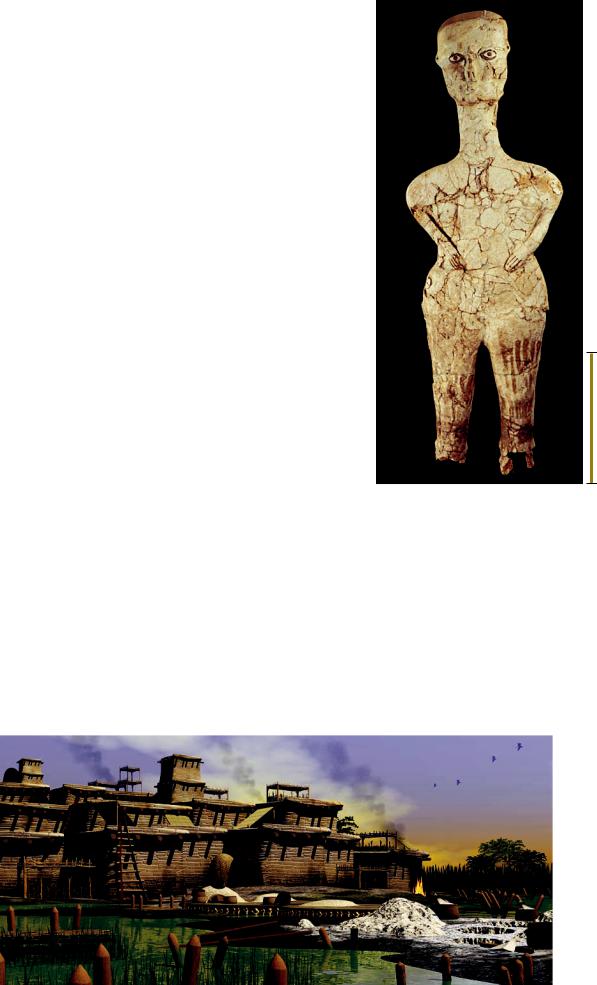
As Jericho’s wealth grew, the need for protection against marauding nomads resulted in the first known permanent stone fortifications. By approximately 7500 BCE, a wide rock-cut ditch and a 5-foot-thick wall surrounded the town, estimated to have had a population of more than 2,000 people. Into the circuit wall, which has been preserved to a height of almost 13 feet, was built a great circular tower (FIG. 1-14) of roughly shaped stones laid without mortar and originally about 30 feet high. Almost 33 feet in diameter at the base, the tower has an inner stairway leading to its summit. (Today, a grate covers the entrance to the stairway.) Not enough of the site has been excavated to determine whether this tower was solitary or one of several similar towers that formed a complete defense system. In either case, a structure as large as this was a tremendous technological achievement and a testimony to the builders’ ability to organize a significant workforce. The walls and tower(s) of Jericho mark the beginning of the long history of monumental architecture.
AIN GHAZAL Near Amman, Jordan, the construction of a highway in 1974 revealed another important Neolithic settlement in ancient Palestine at the site of Ain Ghazal, occupied from ca. 7200 to ca. 5000 BCE. The inhabitants built houses of irregularly shaped stones, but carefully plastered and then painted their floors and walls red. The most striking finds at Ain Ghazal, however, are two caches containing three dozen plaster statuettes (FIG. 1-15) and busts, some with two heads, datable to ca. 6500 BCE. The sculptures appear to have been ritually buried. The figures were fashioned of white plaster, which was built up over a core of reeds and twine. The sculptors used black bitumen, a tarlike substance, to delineate the pupils of the eyes. On some of the later figures painters added clothing. Only rarely did the artists indicate the gender of the figures. Whatever their purpose, by their size (as much as three feet tall) and sophisticated technique, the Ain Ghazal statuettes and busts are distinguished from Paleolithic figurines such as the tiny Venus of Willendorf (FIG. 1-5) and even the foot-tall Hohlenstein-Stadel ivory statuette (FIG. 1-4). They mark the beginning of monumental sculpture in the ancient Near East.
ÇATAL HÖYÜK Remarkable discoveries also have been made in Anatolia. Excavations at Hacilar, Çatal Höyük, and elsewhere have shown that the central Anatolian plateau was the site of a flourishing Neolithic culture between 7000 and 5000 BCE. Twelve successive building levels excavated at Çatal Höyük between 1961 and 1965 have been dated between 6500 and 5700 BCE. On a single site, it is possible to retrace the evolution of a Neolithic culture over a period of 800 years. An
1-15 Human figure, from Ain Ghazal, Jordan, ca. 6750–6250 BCE. Plaster, painted and inlaid with
bitumen, 3 5 3 high.
–8 Louvre, Paris.
The dozens of large white plaster statuettes, some with two heads and with details added in paint, found at Ain Ghazal date to the mid-seventh millennium BCE and are the earliest large sculptures known.
1 ft.
important source of Çatal Höyük’s wealth was trade, especially in obsidian, a glasslike volcanic stone Neolithic toolmakers and weapon makers valued highly because it could be chipped into fine cutting edges. Along with Jericho, Çatal Höyük seems to have been one of the first experiments in urban living. The regularity of its plan suggests that the town was built according to some predetermined scheme. A peculiar feature is the settlement’s complete lack of streets. The houses adjoin one another and have no doors (FIG. 1-16). Openings in the roofs provided access to the interiors. The openings also served as chimneys to ventilate the hearth in the combination living room and kitchen that
1-16 Restored view of a section of Level VI, Çatal Höyük, Turkey, ca. 6000–5900 BCE (John Swogger).
Archaeologists have discovered 12 successive building levels at Çatal Höyük. The houses in this early city adjoined one another and had no doors. Openings in the roofs provided access to the interiors.
Neolithic Art |
11 |
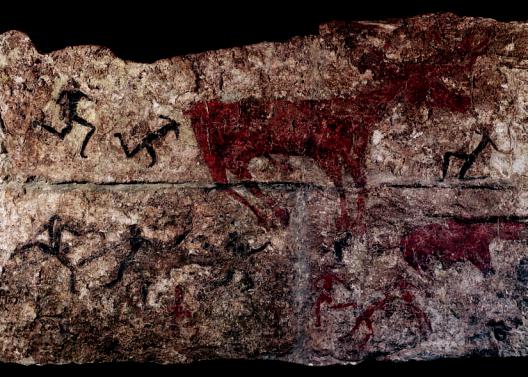
formed the core of the house. Impractical as such an arrangement may appear today, it did offer some advantages. The attached buildings were more stable than freestanding structures and, at the limits of the town site, formed a defensive perimeter wall. If enemies managed to breach the exterior wall, they would find themselves not inside the town but above the houses with the defenders waiting there on the roof.
The houses, constructed of mud brick strengthened by sturdy timber frames, varied in size but repeated the same basic plan. Walls and floors were plastered and painted, and platforms along walls served as sites for sleeping, working, and eating. The dead were buried beneath the same platforms. A great number of decorated rooms have been found at Çatal Höyük. The excavators called these rooms shrines, but their function is uncertain. Their number suggests that these rooms played an important role in the life of Çatal Höyük’s inhabitants.
The “shrines” are distinguished from the house structures by the greater richness of their interior decoration, which consisted of wall paintings, plaster reliefs, animal heads, and bucrania (bovine skulls). Bulls’ horns, widely thought to be symbols of masculine potency, are the most common motif in these rooms. In some cases they are displayed next to plaster breasts, symbols of female fertility, projecting from the walls. Many statuettes of stone or terracotta (baked clay) also have been found at Çatal Höyük. Most are quite small (2 to 8 inches high) and primarily depict female figures. A few reach 12 inches.
Although animal husbandry was well established, hunting continued to play an important part in the early Neolithic economy of Çatal Höyük. The importance of hunting as a food source (until about 5700 BCE) is reflected also in wall paintings, where, in the older decorated rooms, hunting scenes predominate. In style and concept, however, the deer hunt mural (FIG. 1-17) at Çatal Höyük is worlds apart from the wall paintings the hunters of the Paleolithic period produced. Perhaps what is most strikingly new about the Çatal Höyük painting and others like it is the regular appearance of the human figure—not only singly but also in large, coherent groups
1-17 Deer hunt, detail of a wall painting from Level III, Çatal Höyük, Turkey, ca. 5750 BCE. Museum of Anatolian Civilization, Ankara.
This Neolithic painter depicted human figures as a composite of frontal and profile views, the most descriptive picture of the shape of the human body. This format would become the rule for millennia.
with a wide variety of poses, subjects, and settings. As noted earlier, humans were unusual in Paleolithic cave paintings, and pictorial narratives have almost never been found. Even the “hunting scene” (FIG. 1-13) in the well at Lascaux is doubtful as a narrative. In Neolithic paintings, human themes and concerns and action scenes with humans dominating animals are central.
In the Çatal Höyük hunt, the group of hunters—and no one doubts it is, indeed, an organized hunting party, not a series of individual figures—shows a tense exaggeration of movement and a rhythmic repetition of basic shapes customary for the period. The painter took care to distinguish important descriptive details—for example, bows, arrows, and garments—and the heads have clearly defined noses, mouths, chins, and hair. The Neolithic painter placed all the heads in profile for the same reason Paleolithic painters universally chose the profile view for representations of animals. Only the side view of the human head shows all its shapes clearly. However, at Çatal Höyük the torsos are presented from the front—again, the most informative viewpoint—whereas the painter chose the profile view for the legs and arms. This composite view of the human body is quite artificial because the human body cannot make an abrupt 90-degree shift at the hips. But it is very descriptive of what a human body is—as opposed to what it looks like from a particular viewpoint. The technique of painting also changed dramatically since Paleolithic times. The pigments were applied with a brush to a white background of dry plaster. The careful preparation of the wall surface is in striking contrast to the direct application of pigment to the irregularly shaped walls and ceilings of caves.
More remarkable still is a painting (FIG. 1-18 is a watercolor copy) in one of the older rooms at Çatal Höyük that art historians generally have acclaimed as the world’s first landscape (a picture of a natural setting in its own right, without any narrative content). As such, it remained unique for thousands of years. According to radiocarbon dating, the painting was executed around 6150 BCE. The foreground has been interpreted as a town with rectangular houses neatly laid out side by side, probably representing Çatal Höyük itself.
12 Chapter 1 A RT B E F O R E H I S TO RY
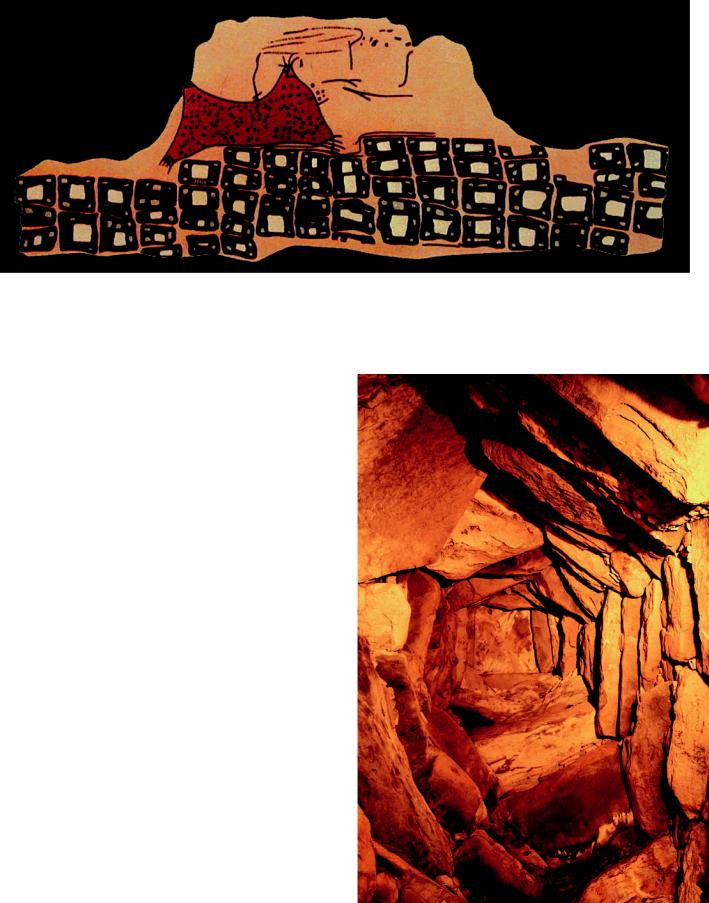
1-18 Landscape with volcanic eruption(?), watercolor copy of a wall painting from Level VII, Çatal Höyük, Turkey, ca. 6150 BCE.
This late-seventh-millennium BCE mural painting may represent Çatal Höyük during a volcanic eruption. It is the first known landscape painting in which neither humans nor animals appear.
Behind the town appears a mountain with two peaks. Many archaeologists think that the dots and lines issuing from the higher of the two cones represent a volcanic eruption, and have suggested that the mountain is the 10,600-foot-high Hasan Da˘g. It is located within view of Çatal Höyük and is the only twin-peaked volcano in central Anatolia. The conjectured volcanic eruption shown in the mural does not necessarily depict a specific historical event. If, however, the Çatal Höyük painting relates a story, even a recurring one, then it cannot be considered a pure landscape. Nonetheless, this mural is the first depiction of a place devoid of both humans and animals.
The rich finds at Çatal Höyük give the impression of a prosperous and well-ordered society that practiced a great variety of arts and crafts. In addition to painting and sculpture, weaving and pottery were well established, and even the technique of smelting lead in small quantities was known before 6000 BCE. The conversion to an agricultural economy appears to have been completed by about 5700 BCE.
Western Europe
In western Europe, where Paleolithic paintings and sculptures abound, no comparably developed towns of the time of Çatal Höyük have been found. However, in succeeding millennia, perhaps as early as 4000 BCE, the local Neolithic populations in several areas developed a monumental architecture employing massive rough-cut stones. The very dimensions of the stones, some as high as 17 feet and weighing as much as 50 tons, have prompted historians to call them megaliths (great stones) and to designate Neolithic architecture employing megaliths as megalithic.
NEWGRANGE One of the most impressive megalithic monuments in Europe is also one of the oldest. The megalithic tomb at Newgrange in Ireland, north of Dublin, may have been constructed as early as 3200 BCE and is one of the oldest burial monuments in Europe. It takes the form of a passage grave, that is, a tomb with a long stone corridor (FIG. 1-19) leading to a burial chamber, all covered by a great tumulus (earthen burial mound). Passage graves have been found also in England, France, Spain, and Scandinavia. All attest to the importance of honoring the dead in Neolithic society. Some mounds contain more than one passage grave. The Newgrange
1-19 Gallery leading to the main chamber of the passage grave, Newgrange, Ireland, ca. 3200–2500 BCE.
The Newgrange passage grave is an early example of corbeled vaulting. The megaliths of the corridor leading to the burial chamber beneath the tumulus are held in place by their own weight.
Neolithic Art |
13 |
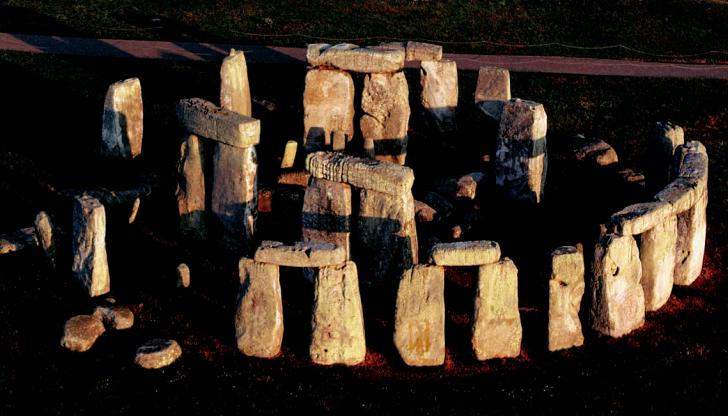
1-20 Aerial view (looking northwest) of Stonehenge, Salisbury Plain, England, ca. 2550–1600 BCE. Circle is 97 in diameter; trilithons 24 high.
The circles of trilithons at Stonehenge probably functioned as an astronomical observatory and solar calendar. The sun rises over its “heel stone” at the summer solstice. Some of the megaliths weigh 50 tons.
tumulus is 280 feet in diameter and 44 feet tall. Its passageway is 62 feet long and is an early example of a construction technique used in other later ancient cultures and even today—the corbeled vault (FIGS. 4-16 and 4-17b). At Newgrange, huge megaliths form the ceiling of the passage and the burial chamber. The stones are held in place by their own weight, those on one side countering the weight of the megaliths on the other side of the passageway. Some of the stones are decorated with incised spirals and other abstract motifs (not visible in FIG. 1-19). A special feature of the Newgrange tomb is that at the winter solstice the sun illuminates the passageway and the burial chamber.
HAGAR QIM Contemporary with Newgrange but on an island far to the south is the megalithic temple (FIG. 1-1) of Hagar Qim, one of many constructed on Malta between 3200 and 2500 BCE and one of the oldest stone temples anywhere in the world. The Maltese builders constructed their temples by piling carefully cut stone blocks in courses (stacked horizontal rows). The doorways at Hagar Qim were built using the post-and-lintel system (FIG. 4-17a) in which two upright stones (posts) support a horizontal beam (lintel). The layout of this and other Neolithic Maltese temples is especially noteworthy for the combination of rectilinear and curved forms, including multiple apses (semicircular recesses). Inside the Hagar Qim temple archaeologists found altars (hence the identification of the structure as a religious shrine) and several stone statues of headless
nude women, one standing, the others seated. The level of architectural and sculptural sophistication seen on this isolated island at so early a date is extraordinary.
STONEHENGE The most famous megalithic monument in Europe is Stonehenge (FIG. 1-20) on the Salisbury Plain in southern England. A henge is an arrangement of megalithic stones in a circle, often surrounded by a ditch. The type is almost entirely limited to Britain. Stonehenge is a complex of rough-cut sarsen (a form of sandstone) stones and smaller “bluestones” (various volcanic rocks) built in several stages over hundreds of years. The final henge took the form of concentric post-and-lintel circles. The outer ring, almost 100 feet in diameter, consists of huge sarsen megaliths. Inside is a ring of bluestones, which in turn encircle a horseshoe (open end facing east) of trilithons (three-stone constructions)—five linteltopped pairs of the largest sarsens, each weighing 45 to 50 tons. Standing apart and to the east (outside the aerial view in FIG. 1-20) is the “heel stone,” which, for a person looking outward from the center of the complex, would have marked the point where the sun rose at the summer solstice. Stonehenge seems to have been a kind of astronomical observatory and a remarkably accurate solar calendar.
The megalithic tombs, temples, and henges of Europe are enduring testaments to the rapidly developing intellectual powers of Neolithic humans as well as to their capacity for heroic physical effort.
14 Chapter 1 A RT B E F O R E H I S TO RY

T H E B I G P I C T U R E
A R T B E F O R E H I S T O RY
PALEOLITHIC (OLD STONE AGE) ART, ca. 30,000–9000 BCE
The first sculptures and paintings antedate the invention of writing by tens of thousands of years. Paleolithic humans’ decision to represent the world around them initiated an intellectual revolution of enormous consequences.
No one knows why humans began to paint and carve images or what role those images played in the lives of Paleolithic hunters. Women were far more common subjects than men, but animals, not humans, dominate Paleolithic art.
The works created range in size from tiny figurines like the so-called Venus of Willendorf to painted walls and ceilings covered with over-life-size animals, as in the cave at Lascaux.
Artists always depicted animals in profile so that the image was complete, including the head, body, tail, and all four legs. This format persisted for millennia.
NEOLITHIC (NEW STONE AGE) ART, ca. 8000–2300 BCE
Around 9000 BCE, the ice that had covered much of northern Europe for millennia receded. After a transitional period, the Neolithic Age began, but at different times in different places. It also continued longer in remote places like Stonehenge in England and Hagar Qim on Malta.
The Neolithic Age revolutionized human life with the beginning of agriculture and the formation of the first settled communities, like that at Çatal Höyük in Anatolia.
In art, the Neolithic period saw the birth of monumental sculpture, notably the painted plaster figurines from Ain Ghazal, and of monumental stone architecture in the walls and tower(s) of Jericho.
In painting, coherent narratives became common and artists began to represent human figures
as composites of frontal and profile views—another formula that would remain universal for a very long time.
Nude woman (Venus of Willendorf ), ca. 28,000–25,000 BCE
Hall of the Bulls, Lascaux,
ca. 15,000–13,000 BCE
Plaster figurine, Ain Ghazal, ca. 6750–6250 BCE
Stonehenge, Salisbury Plain,
ca. 2550–1600 BCE
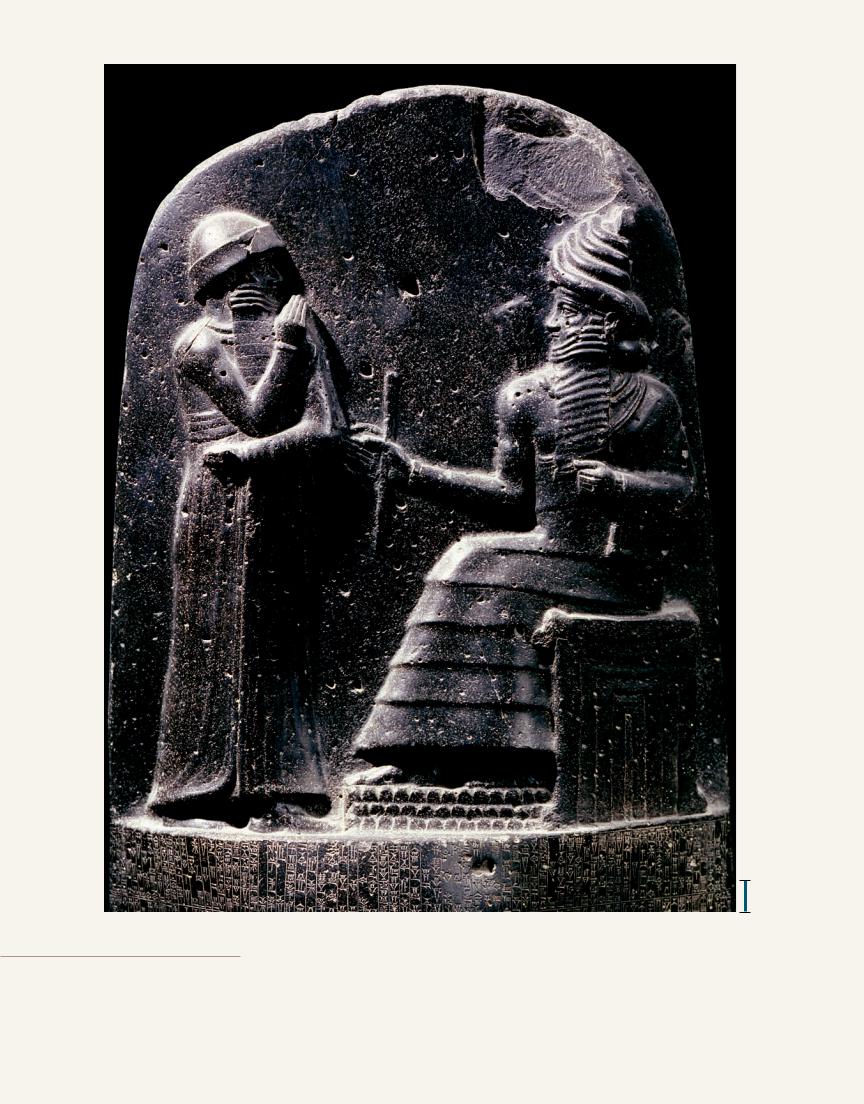
1 in.
2-1 Hammurabi and Shamash, detail of the stele of Hammurabi (FIG. 2-17), from Susa, Iran, ca. 1780 BCE.
The relationship between king and god in the ancient Near East is set out on this Babylonian stele representing the sun god extending to Hammurabi the symbols of his authority to govern and enact laws.
